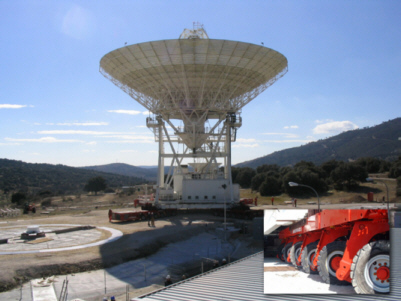
Giant Deep Space Network antenna in Madrid is moved using four 12-axle, 24-wheel crawlers.

Moving a Mountain of a Dish
by Patrick L. Barry
Your first reaction: “That’s impossible!”
How on earth could someone simply pick up one of NASA’s giant Deep Space Network (DSN) antennas—a colossal steel dish 12 stories high and 112 feet across that weighs more than 800,000 pounds—move it about 80 yards, and delicately set it down again?
Yet that's exactly what NASA engineers recently did.
One of the DSN dishes near Madrid, Spain, needed to be moved to a new pad. And it had to be done gingerly; the dish is a sensitive scientific instrument full of delicate electronics. Banging it around would not do.
“It was a heck of a challenge,” says Benjamin Saldua, the structural engineer at JPL who was in charge of the move. “But thanks to some very careful planning, we pulled it off without a problem!”
The Deep Space Network enables NASA to communicate with probes exploring the solar system. Because Earth is constantly rotating, a single antenna on the ground can communicate with a probe for only part of the day, when the probe is overhead. By placing large dishes at three locations around the planet—Madrid, California, and Australia—NASA can maintain contact with spacecraft around the clock.
To move the Madrid dish, NASA called in a company from the Netherlands named Mammoet, which specializes in moving massive objects. (Mammoet is the Dutch word for “mammoth.”)
On a clear day (bad weather might blow the dish over!), they began to slowly lift the dish. Hydraulic jacks at all four corners gradually raised the entire dish to a height of about 4.5 feet. Then Mammoet engineers positioned specialized crawlers under each corner. Each crawler looks like a mix between a flatbed trailer and a centipede: a flat, load-bearing surface supported by 24 wheels on 12 independently rotating axes, giving each crawler a maximum load of 194 tons!
One engineer took the master joystick and steered the whole package in its slow crawl to the new pad, never exceeding the glacial speed of 3 feet per minute. The four crawlers automatically stayed aligned with each other, and their independently suspended wheels compensated for unevenness in the ground.
Placement on the new pad had to be perfect, and the alignment was tested with a laser. To position the dish, believe it or not, Mammoet engineers simply followed a length of string tied to the pad’s center pivot where the dish was gently lowered.
It worked. So much for “impossible.”
Find out more about the DSN at http://deepspace.jpl.nasa.gov/dsn/. Kids can learn about the amazing DSN antennas and make their own “Super Sound Cone” at The Space Place, http://spaceplace.nasa.gov/en/kids/tmodact.shtml.

Giant Deep Space Network antenna in Madrid is moved using
four 12-axle, 24-wheel crawlers.
This article was provided by the Jet Propulsion Laboratory, California Institute of Technology, under a contract with the National Aeronautics and Space Administration.
All content is the responsibility of LUNAR.
If you have comments or suggestions regarding these web pages,
please contact the 
Copyright © 1992 - 2025 LUNAR